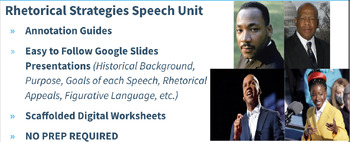Rhetoric Meets Social Justice Speech Unit (NO PREP)
- Google Slides™

Description
Empower Your Students with the Voices of Change!
Looking to inspire your students to become advocates for justice and equality? My comprehensive multi-lesson unit is the perfect resource to engage students in meaningful discussions and critical analysis of speeches by Dr. King, Bryan Stevenson, Amanda Gorman, and John Lewis.
Dive into History: Explore the historical context surrounding Dr. King's "I Have a Dream" speech and Bryan Stevenson's TED talk on mass incarceration. With engaging Google Slides presentations, students will uncover the events and social issues that shaped these iconic speeches, from the civil rights movement to the modern-day fight for justice.
Analyze Rhetorical Strategies: Delve into the power of persuasion with presentations on rhetorical appeals and figurative language. My guided notes activities and analysis worksheets empower students to dissect the rhetorical strategies used by these influential speakers, including ethos, pathos, and logos.
Scaffolded Learning: Cater to diverse learners with digital analysis worksheets offering options for scaffolding. Choose between sentence frames or open-ended prompts to support student comprehension and critical thinking at every step.
Seamless Lesson Planning: Streamline your teaching with my teacher-friendly Google Slides presentations. With clear objectives, agendas, and resources provided for each lesson, you can focus on facilitating meaningful learning experiences for your students.
Inspire Active Citizenship: Spark discussions about the power of speech and the role of individuals in creating positive change. With Amanda Gorman's inspiring words and John Lewis' call to action, students will reflect on their responsibility to contribute to a more just and equitable society.
Assess Understanding: Measure student mastery with my comprehensive summative assessment, including a choice board and rhetorical precis activity. My analytic rubric ensures fair and accurate evaluation of student work, empowering you to track progress and provide targeted feedback.
Don't miss out on this opportunity to engage your students, foster critical thinking, and inspire social responsibility. Purchase my multi-lesson unit on today and empower your students to amplify the voices of change!





